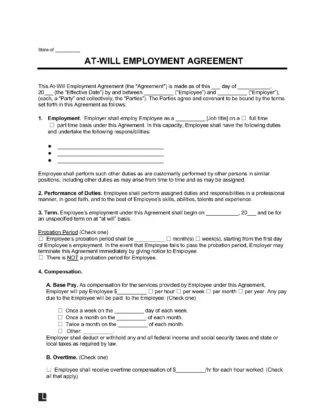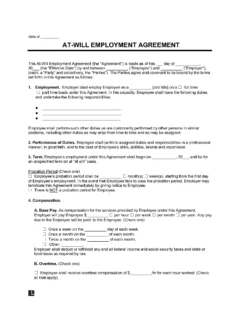
Use an At-Will Employment Contract for workforce flexibility in response to market forces.

Updated August 19, 2024
Written by Josh Sainsbury | Reviewed by Brooke Davis
An at-will employment contract is a legally binding agreement that an employee will work for an employer with no set end date. The employer or employee can terminate the agreement at any time, within the confines of the law and the terms of the contract itself.
An at-will employment contract template can streamline the contracting process and ensure you include the necessary details.
Use our at-will employment contract template, available in PDF and Word, to streamline your hiring process:

At-will employment means employees provide their work to the employer indefinitely [1] . Employees may choose at-will hire vs. contract for a fixed term if they wish to advance their career and their employer does not have available opportunities.
An at-will agreement lets the employee depart the company when an advancement opportunity arises elsewhere.
Employers benefit from this type of employment when they need hiring flexibility but do not want a freelancer or independent contractor.
An at-will employer can hire employees when needed and let them go as necessary without risking legal consequences. It is important to note that employers can still be liable for wrongful termination if they violate federal or state employment laws [2] .
While both parties can terminate an at-will agreement at their discretion, certain exceptions still apply. These exceptions exist on a federal and state level.
The following federal laws prohibit employers from firing employees due to discrimination, retaliation, or refusal to perform illegal or unsafe acts [3] :
Wrongful termination may also occur if the company fires someone for another person’s mistake or they fail to follow established termination procedures.
At-will employment exceptions vary by state. They may include the following types of exceptions:
States may also have laws that cover intentional interference, intentional emotional distress, retaliation, whistleblowing, and termination without good cause [6]. If you need clarification on which laws apply to your at-will contract, consult a local employment attorney before signing.
| State | Public Policy Exemption | Covenant of Good Faith | Implied Contract Exception |
|---|---|---|---|
| Alabama | No | Yes | Yes |
| Alaska | Yes | Yes | Yes |
| Arizona | Yes | Yes | Yes |
| Arkansas | Yes | Yes | Yes |
| California | Yes | Yes | Yes |
| Colorado | Yes | Yes | Yes |
| Connecticut | Yes | Yes | Yes |
| Delaware | Yes | Yes | No |
| Florida | No | No | No |
| Georgia | No | No | No |
| Hawaii | Yes | Yes | Yes |
| Idaho | Yes | Yes | Yes |
| Illinois | Yes | Yes | Yes |
| Indiana | Yes | Yes | No |
| Iowa | Yes | Yes | Yes |
| Kansas | Yes | Yes | Yes |
| Kentucky | Yes | Yes | Yes |
| Louisiana | No | No | No |
| Maine | No | No | Yes |
| Maryland | Yes | Yes | Yes |
| Massachusetts | Yes | Yes | No |
| Michigan | Yes | Yes | Yes |
| Minnesota | Yes | Yes | Yes |
| Mississippi | Yes | Yes | Yes |
| Missouri | Yes | Yes | No |
| Montana * | Yes | Yes | No |
| Nebraska | No | Yes | Yes |
| Nevada | Yes | Yes | Yes |
| New Hampshire | Yes | Yes | Yes |
| New Jersey | Yes | Yes | Yes |
| New Mexico | Yes | Yes | Yes |
| New York | No | Yes | Yes |
| North Carolina | Yes | Yes | No |
| North Dakota | Yes | Yes | Yes |
| Ohio | Yes | Yes | Yes |
| Oklahoma | Yes | Yes | Yes |
| Oregon | Yes | Yes | Yes |
| Pennsylvania | Yes | Yes | No |
| Rhode Island | No | No | No |
| South Carolina | Yes | Yes | Yes |
| South Dakota | Yes | Yes | Yes |
| Tennessee | Yes | Yes | Yes |
| Texas | Yes | Yes | No |
| Utah | Yes | Yes | Yes |
| Vermont | Yes | Yes | Yes |
| Virginia | Yes | Yes | No |
| Washington | Yes | Yes | Yes |
| West Virginia | Yes | Yes | Yes |
| Wisconsin | Yes | Yes | Yes |
| Wyoming | Yes | Yes | Yes |
| Show More Show Less | |||
While at-will employment typically allows employers to terminate the employee without cause, employees cannot be terminated for any of the following reasons:
Most at-will workers also have a right to regular and overtime pay at or above the state or federal minimum wage for work performed in accordance with their contract [7]. Check your state and local laws to determine the proper wage designation for your at-will contract.
An at-will employment contract should include the following information:
Depending on the level of confidentiality your company requires, you may include an employee non-disclosure agreement in your contract paperwork. Non-disclosure agreements prevent the dissemination of trade secrets and proprietary information whose disclosure would be detrimental to the company.
Take the following steps to create an at-will employment contract:
Fill in the initial statement to introduce the employer and employee. The introduction should include the names of the employer and employee and the agreement date. It should also state that both parties agree to be bound by the contract terms.
This section should include the duties the employee will perform under the agreement. Please indicate whether the employee works full or part-time and explain their responsibilities. Enter the starting date of the contract and specify that the terms are at-will.
You should also state the employee’s work location and expected hours, if applicable.
Indicate the employee’s compensation for their work hourly, weekly, monthly, or annual. Advise how frequently the employee will receive payment for their work, whether bi-weekly, monthly, bi-monthly, or another term. Address overtime, paid holidays, paid time off, reimbursable expenses, and other benefits.
Add this information to the contract if your employee will receive a commission, bonuses, or other benefits. Provide details about disability benefits, sick leave, and personal leave.
If you wish to prevent the employee from working with competitors while they work for you, include a non-compete clause detailing these terms.
Delineate expectations for how the employee is to handle confidential and proprietary information. Advise whether work performed by the employee on behalf of the company becomes the company’s property. Include information about legal recourse should the employee breach confidentiality or intellectual property policies.
Outline the laws, statutes, and regulations governing your at-will agreement. Indicate which state laws apply to the contract and whether disagreements will be handled through arbitration, mediation, or litigation.
Your at-will employment agreement should include space for the employee’s full name and signature and the employer’s full name, title, and signature. Once both parties sign the contract, it is legal and binding.
View SourcesLegal Templates uses only high-quality sources, including peer-reviewed studies, to support the facts within our articles. Read our editorial guidelines to learn more about how we keep our content accurate, reliable and trustworthy.

Create an At-Will Employment Contract here!